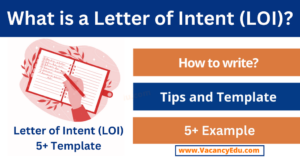What is a letter of intent (LOI)?
A letter of intent (LOI) is a document used in various fields and industries to outline the preliminary understanding between two or more parties regarding a proposed transaction, agreement, or negotiation. It serves as a formal way to express an individual or organization’s interest in engaging in a particular business deal, partnership, acquisition, employment, or any other arrangement.
The key purpose of an LOI is to establish the fundamental terms and conditions that the involved parties intend to adhere to as a basis for future negotiations. While an LOI is typically considered non-binding, meaning it’s not a formal agreement, it does signify a serious commitment and intention to proceed with negotiations toward a final agreement.
What is included in a letter of intent?
Essentially, an LOI acts as a roadmap for discussions, setting out the main points and terms both parties are inclined to agree upon. It often covers essential elements such as:
Identification of Parties: Clearly specifying the parties involved in the prospective deal and their roles or responsibilities.
Objective and Purpose: Outlining the primary purpose and objectives of the intended agreement or transaction.
Basic Terms and Conditions: Describing key terms, such as the scope of work, pricing, deadlines, responsibilities, and any specific requirements crucial for the agreement.
Exclusivity or Confidentiality Clauses: Including provisions that might limit both parties from sharing sensitive information with others or engaging in similar negotiations for a specified period.
Non-binding Nature: Clearly stating that the letter is a declaration of intent to negotiate and not a final, legally binding agreement. However, certain sections might be considered binding, especially those related to confidentiality or exclusivity.
Timeline: In some cases, it might include a proposed timeline for finalizing the agreement or moving forward with the next steps.
Why a letter of intent important?
For enterprises and other groups, a letter of intent can be an essential tool.
In order to ensure that everyone involved in a proposed transaction understands what is being agreed upon, it first helps to clarify the terms of the agreement. This clarity lowers the possibility of misconceptions that can cause the transaction to go awry.
By fostering understanding and a common goal for the transaction, a letter of intent can increase trust between the parties. By stating the conditions and expectations up front, they can also speed up the conclusion of a transaction by simplifying the negotiating and execution process.
For example, let’s say that two businesses are about to merge. They would gain by signing a letter of intent outlining the conditions of the merger, including details on the exchange ratio, the merger price, and the expected merger date.
By ensuring that both businesses have similar expectations, this calculated move reduces the possibility of unforeseen difficulties when it comes time to execute the merger agreement.
What are the risks of using a letter of intent?
While a letter of intent (LOI) is a valuable tool in initiating negotiations and outlining preliminary terms for an agreement, there are potential risks associated with its use:
Misinterpretation: Ambiguity in the language or terms within the LOI might lead to misunderstandings, causing discrepancies during the negotiation process. Parties might interpret the terms differently, resulting in disagreements or stalled negotiations.
Legal Ambiguity: If not carefully drafted, certain parts of the LOI might unintentionally create legally binding obligations, even if the document is supposed to be non-binding. This could lead to unintended commitments or liabilities.
Expectation Misalignment: There’s a risk that one party might invest more time, effort, or resources into negotiating the deal based on the LOI than the other party. If the expectations regarding commitment differ, it might result in frustration or unbalanced efforts.
Stalled Negotiations: Parties might become complacent after signing an LOI, assuming the deal is as good as done. However, negotiations can still fall through, leading to wasted time and resources invested in discussions that don’t culminate in a final agreement.
Confidentiality Concerns: While an LOI might include clauses regarding confidentiality, leaks of sensitive information or trade secrets to competitors could occur before a formal agreement is established, risking the competitive edge of the involved parties.
Exclusivity Issues: If an LOI includes an exclusivity clause, it might limit one party’s ability to engage in negotiations with other potential partners or options during the specified period, potentially missing out on better opportunities.
Costs Involved: The time, effort, and costs invested in drafting, reviewing, and negotiating an LOI might not materialize into a final agreement, resulting in resources spent without achieving a deal.
Tips for how to write a letter of intent
I wanted to provide some advice on creating a letter of intent because the deadlines for applying to research posts are drawing near. You can start writing your letter of intent (LOI) by using the template provided in this blog article, which will walk you through the key sections of the document.
- Always Use a letterhead.
- contact information is must.
- End the letter with a complimentary close.
- Don’t make excuses.
- Use correct syntax.
- Having the correct grammar and spelling.
- Not making the statement too detailed or too general
- Using proper formatting for the document
How to write a strong letter of intent?
You must address some aspects of the job description in your letter of intent (LOI), such as the necessary experience and how your qualifications align with the goals of the organization. Enumerate the top three qualifications from the job description that you believe will make you a strong candidate. Additionally, demonstrate your familiarity with the organization through study and your possession of the most desirable attributes for the role.
- Give you a few reasons why you are applying
- Explain your resume and how it ties in to the job
- Explain your interview
- Explain why you want to work for this company and why you are qualified for the job
A letter of intent is an educational document that summarizes your training, professional background, and career objectives. It can also be utilized to express your interest in the position that you are applying for. An LOI is often professionally drafted and need to be sent prior to job application.
To complete the application process for the research job, a letter of intent (LOI) must be sent with the application letter. Another way to refer to the LOI is as a letter of interest or motivation. A brief summary of the study topic to be included in the application is included in the letter of intent. Typically, the letter of intent is written by the applicant. A research funding applicant may find the letter of purpose helpful as well. For the research post, the application letter and the letter of intent must be sent together.
What should be included in a letter of intent?
By signing a letter of intent (LOI), you essentially tell your potential employer that you are interested in the job they are providing and that you are prepared to sign an official employment contract as soon as you receive the offer. A few things should be included in this letter. It should begin with a summary of your aims, a statement of your general interest in the position, and an explanation of how your qualifications would benefit the business. Secondly, it must to have a synopsis of your credentials for the position. This can contain prior employment history, qualifications, and honors.
Candidates are frequently requested to prepare a letter of intent (LOI). This letter serves as a kind of preliminary inquiry, providing hiring managers with a brief overview of the applicant’s motivations for wanting to work with them. A brief biography, a list of the applicant’s credentials, and a declaration of interest in the job are typically included in the LOI. The letter of intent needs to be formal and succinct. A letter of intent should be submitted with a polished resume and cover letter from the applicant.
What is purpose of letter of intent?
When submitting an application for a grant or a research job, an applicant’s letter of intent serves as proof of their qualifications and commitment to the position or project. The specifics of the job or project, such as its start and completion dates, compensation, and benefits, may also be covered.
Before the contract is signed, both parties get a letter of intent, which aids in understanding the specifics and facilitating the preparation of the required paperwork. It is typically sent to the opposite party’s official correspondence channel, which is typically a secretary or another administrative contact. Additionally, it will be forwarded to the relevant person at the other organization, typically a human resources officer. It is significant to remember that the letter of intent’s structure is completely optional. It is essentially a letter, one page or longer, outlining the terms and conditions as well as the goal of the contract.
How to write a letter of intent?
A letter of intent, sometimes referred to as a statement of purpose, is a written document that outlines your long-term goals. It assists you in defining your objectives and outlining your strategy for achieving them. Although it can be used for various purposes, such as graduate school applications and employment applications, a letter of intent is frequently utilized when applying for research positions.
Are you looking for tips on how to write a letter of intent for a position in research? How can you determine what information belongs in your letter of intent? What ought to be included in the letter of intent and what ought not to be included? What actions are necessary to ensure the effectiveness of your letter of intent? Review the responses to these and other pertinent questions before starting to compose your letter of intent.
What is difference between LOI and LOA?
Letter of Intent (LOI):
Purpose: An LOI outlines the preliminary understanding and agreement between parties to enter into future negotiations. It expresses a serious interest in pursuing a deal or transaction. It’s typically non-binding and serves as a roadmap for further discussions.
Non-binding Nature: Generally, an LOI is not a legally enforceable document, but it does set the stage for a formal agreement. However, specific sections within the LOI, such as confidentiality clauses, might be binding.
Key Elements: It includes the basic terms and conditions, parties involved, the purpose of the intended agreement, and sometimes outlines a proposed timeline for negotiations.
Letter of Agreement (LOA):
Purpose: An LOA is a more formal document that signifies an agreement between parties on specific terms and conditions. It outlines the details of the agreement reached after negotiations.
Legally Binding: Unlike an LOI, an LOA is typically a legally binding contract. It delineates the agreed-upon terms and conditions that both parties are obligated to follow.
Specificity: An LOA is more detailed and comprehensive, covering the specifics of the agreement, responsibilities, deliverables, timelines, and any other terms agreed upon during negotiations.
In summary, an LOI is a preliminary document indicating an intention to negotiate, while an LOA is a more formal and legally binding agreement that details the terms and conditions agreed upon after negotiations have been completed. The LOI sets the stage for discussions, while the LOA formalizes and solidifies the terms of the finalized agreement.
What does a letter of intent include?
A letter of intent is a written statement outlining the conditions of a grant proposal or upcoming contract. Despite not having legal force behind them, letters of intent are a common first step in the application process for corporations and funders. Generally speaking, a letter of purpose explains the organization’s goals and justifies the necessity for funds or a contract. It also contains a budget breakdown and the project’s timeline.
A letter of intent is a document that expresses a person or organization’s desire to do research. The purpose of the individual or the organization is stated in this letter. In addition, this letter includes a list of the materials that were used for the research. This letter also includes additional information, such as the purpose and methodology of the research.
A letter of intent is a document that applicants send to prospective employers indicating their desire to apply for a position that becomes available after they have finished their present degree program or job obligations. This letter of intent expresses your interest in applying, but it is not an application.
Is letter of intent a legal document?
Usually, a letter of intent is not a legally binding document; rather, it is intended to be the start of a procedure. An intent to enter into a legal agreement (such as a contract, lease, or memorandum of understanding) may be expressed through the LOI. It can also be used to signal a desire to start the process of negotiating a formal contract.
What is the difference between letter of intent and application letter?
The primary difference between a Letter of Intent (LOI) and an Application Letter lies in their purpose and content:
Letter of Intent (LOI):
Purpose: An LOI is a document expressing a preliminary commitment or serious interest in a potential agreement, partnership, acquisition, or transaction. It outlines the basic terms and conditions for a future negotiation or agreement.
Non-binding Nature: Typically, an LOI is non-binding, signaling an intention to negotiate rather than a legally enforceable agreement. However, certain clauses within the LOI might be binding, such as confidentiality clauses.
Basic Terms: It generally covers the parties involved, the purpose of the intended agreement, and outlines the fundamental terms and conditions to be negotiated.
Application Letter:
Purpose: An application letter, commonly used when applying for a job or admission to an educational program, is a formal document that serves as an introduction to the candidate. Its primary aim is to showcase the candidate’s qualifications, skills, and interest in the position or program.
Targeted at a Specific Role or Program: An application letter is tailored to a specific job opening or educational program, highlighting the candidate’s suitability and interest in that particular role or academic pursuit.
Includes Personal Background and Skills: It usually includes the candidate’s qualifications, experience, skills, and achievements relevant to the position or program applied for, along with a brief explanation of their interest in the opportunity.
In essence, an LOI expresses preliminary commitment or serious interest in a potential business agreement, while an application letter is a tailored document that presents a candidate’s qualifications and interest in a specific job or educational opportunity. The key distinction lies in their purpose and content—LOIs for preliminary business engagements, while application letters for job or academic applications.
What is the difference between letter of intent and cover letter?
Cover letters and letters of intent are similar documents you can use to contact a target employer in your job search. With either type of letter, you should aim for a confident tone that outlines your skills and presents you as a talented professional in your field. However, these two items have key differences and are used in different contexts. Cover letters are for pursuing individual jobs, while letters of intent are for pursuing companies that interest you in general.
What’s Included in a Letter of Intent
To write a professional letter of intent, you should add the below sections:
- Contact details: include them at the top of the letter.
- Salutation: use “Dear John Smith,” instead of “To Whom It May Concern,”
- First paragraph: introduce yourself and why you’re writing to the company. You can mention a specific role you have in mind, but focus mostly on expressing plenty of interest in the company itself.
- Second paragraph: mention your greatest accomplishments and skills with a couple of good examples.
- Third paragraph: explain why you’re interested in joining the company and how you’d think you’d be a great fit. Add a call to action to request an informational interview and discuss opportunities for you in the company.
- Professional closing.
What’s Included in a Cover Letter
To make sure your cover letter is turning heads, follow these tips:
- Add your up to date contact details as well as the employer’s in your cover letter heading.
- Include a professional cover letter salutation, preferably using the hiring manager’s name.
- Start your cover letter with an intriguing opening paragraph that introduces you and the role you’re applying for.
- Demonstrate your value by using examples and achievements that show you have the experience and skills the company is looking for.
- Mention your interest in the company and how you believe you’d be the perfect fit to the team. Add a call to action and ask for a call or meeting to discuss your experience further.
- End your cover letter with a professional cover letter closing.
- If necessary, add a cover letter enclosure.
What should be included in a letter of intent?
The following information should be included in an intent letter.
- The reason why you are writing
- Signing Authority
- Functionality
- The main body of the document
What is Letter of Intent sample?
Letter of Intent sample 1
Dear Sir/Madam,
I was surprised to see your advertisement for a postdoc position at the Faculty of Chemistry and Chemical Engineering at the University of Oxford. I am delighted to have found a company that is committed to research and innovation at its core.
I recently completed my Ph.D. in solar cell engineering, and I am looking for exciting opportunities to carry on my research into organic semiconductor materials, their synthesis, characterization, and device fabrication. I am interested in solar cell engineering which I have been working on for the past 2 years. My doctoral thesis is focused on the design and synthesis of new tandem organic semiconductor materials.
I received my undergraduate degree in chemical engineering from the Indian Institute of Technology, Kanpur. I have your own unique blend of skills and experience, not just scientific but also teamwork, material synthesis experience, and leadership!
Thank you for your consideration and have a lovely day.
Regards,
Dr. XYZ
Letter of Intent sample 2
Dear University of Alberta,
I’m a postdoctoral research fellow in solar cell technology. After completing my Ph.D. in energy conversion from the University of Birmingham in England, I received a 2-year postdoc position at the U.S. Department of Energy’s National Renewable Energy Laboratory in Colorado. I have extensive experience with material synthesis and my expert knowledge of silicon solar cell technologies. I have started and managed my team with a focus on teamwork and collaboration.
My extensive experience and varied skill set will be an asset and allow for you to benefit as well. I look forward to discussing this opportunity further. Please let me know if you require additional information or would like to set up an interview.
Regards,
Dr. ABC
Letter of Intent sample 2
Dear Cambridge,
I am writing to submit my candidacy for the post of the researcher in the Department of Chemistry. I have a 2-year postdoc experience, and my research interests are in solar cells with a specialty in material synthesis. I am interested in understanding the conversion of light into electrons and vice versa and my curiosity in the physical and chemical properties of materials organometallic species.
I am confident that I would bring a lot of value to your research department and have the ability to work productively in teams and be able to take charge when needed. I believe that my experience in visualizing and synthesizing organometallic species would be a useful asset for your department.
You can find more information about my CV on my profile page on your website.
It would be an honor to be considered for this role or to speak with you about it. Thank you for your time and consideration.
Sincerely,
Dr. ABC
These are general samples of letters of intent; you should adjust the length and other elements based on the requirements for the post.
An ordinary LOI A letter of intent, also known as a letter of intent or LoI in legal writing (though this term is only capitalized when referring to a particular document under discussion), is a document that summarizes the understanding that two or more parties have and that they hope to formalize in a legally binding agreement. The heads of agreement term sheet memorandum of understanding and this notion are comparable. These described agreements might be leases for real estate, joint ventures, merger and acquisition transaction agreements, or any number of other types of agreements that could control significant transactions.(en.wikipedia.org)
A letter of intent (LOI) is a document declaring the preliminary commitment of one party to do business with another. The letter outlines the chief terms of a prospective deal. Commonly used in major business transactions, LOIs are similar in content to term sheets. One major difference between the two, though, is that LOIs are presented in letter formats, while term sheets are listicle in nature. (investopedia.com)
Related Posts
- Online PhD Programs: Pros and Cons, Universities, Courses, Career.

- Top Websites to Create and Download Free Resume Templates

- Top 25 Free Statistical Analysis Software 2024

- What is a letter of intent (LOI)? Meaning with Sample

- Polite Follow-Up Email to Professor : When and How You should Write

- PhD in Psychology : Career, Admission Process, Benefits, Opportunities.

- What is PhD : Meaning, How to Do, Benefits, Full Details

- How to Write a Motivation Letter for PhD, Postdoc, or Any Position: Sample Motivation Letter

- How to increase Brain Power – Secrets of Brain Unlocked

- Postdoc Application Cover Letter Template

- How to write a Postdoc Job Application or Email

- How to Write a Curriculum Vitae (CV) for a Job Application

- Five Steps of Writing a Great Resume

- How to Write an Effective Cover Letter

















